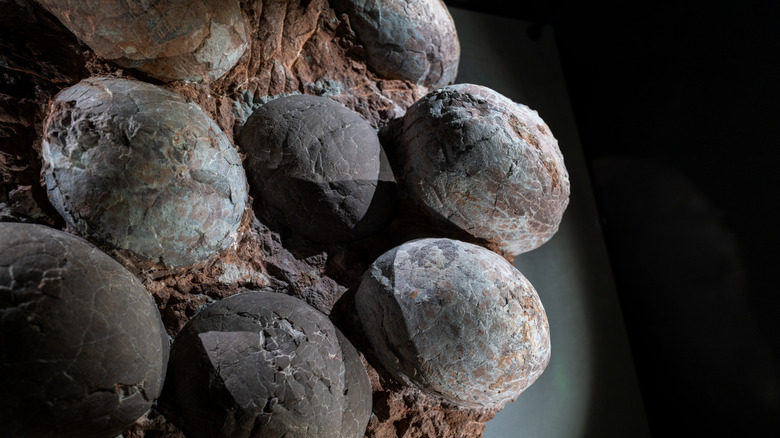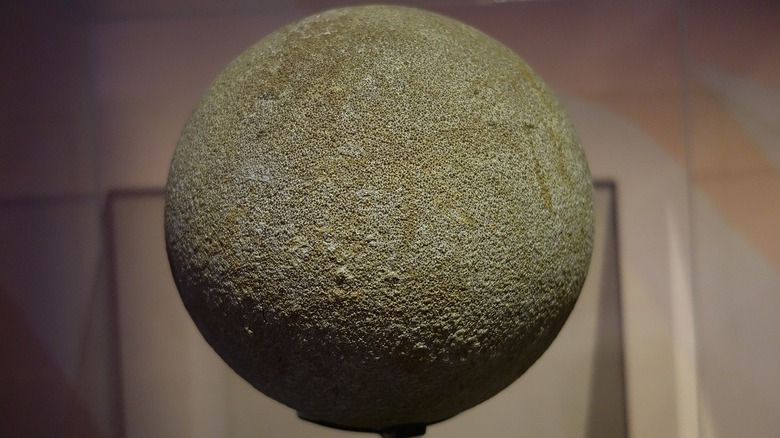What Dinosaur Eggs Really Looked Like
Debates about what dinosaurs look like have been raging for decades, and the appearance of their eggs is equally contested. Although the fossil record can provide paleontologists with clear clues about internal structures, such as bones and muscle attachments, traces of external structures are almost always lost to time. Still, we occasionally get lucky. An Archaeopteryx fossil discovered in 1861 clearly reveals feathers, while a nodosaur fossil found in 2011 preserves the impression of its guts, coat of armor, and skin. Such discoveries are considered "one in a billion," and remnants of dinosaur eggs are equally as elusive.
Conveniently, we can use DNA to ascertain the types of eggs that dinosaurs laid. All non-avian dinosaurs went extinct 66 million years ago, though some avian dinosaur species survived and evolved into modern birds. As a result, even the extinct dinosaurs still live on in much of our DNA, since dinosaurs, birds, reptiles, and mammals are all amniotes and share a common ancestor. The term "amniote" refers to vertebrates whose embryos grow within a closed membrane. Amniote eggs are distinctly different from those of non-amniotes, such as squishy frog eggs and sticky fish eggs.
Dinosaurs being amniotes provide paleontologists with clues towards uncovering what dinosaur eggs looked like, as the genetic kinship of extinct dinosaurs and birds can be used as a jumping-off point. For instance, a 2018 article published in Nature describes how the adaptation that gives bird eggs their unique coloration was also present in theropod dinosaurs. Therefore, many dinosaur eggs exhibited the same variety of colors as modern bird eggs, with blues, reds, whites, tans, browns, and greens, as well as spotted and speckled patterns. But their shapes and sizes, however, were notably different from bird eggs, and there are a handful of fossilized dinosaur eggs to prove it.
The many shapes and sizes of dinosaur eggs
In the same way dinosaur eggs had a diverse array of colors, they also varied in size and shape. However, most dinosaur egg fossils are broken fragments, making it difficult for paleontologists to identify the species to which the egg originally belonged. In such cases, a classification system called "parataxonomy" is used, which organizes egg specimens into a daunting array of shape descriptions.
There are many examples of the different shapes dinosaur eggs could be. Troodons were a clade of small bird-like dinosaurs with short serrated teeth that lived during the third and final time period of the dinosaurs, the Cretaceous. Like bird eggs, Troodon eggs were ovoid in shape but longer and narrower. Hadrosaurs, those famous "duck-billed" creatures, laid eggs that can only be described as spherical, with an almost perfectly uniform radius and no distinct top or bottom. There are also the Oviraptors, which included the 26-foot-long beaked Gigantoraptor. Oviraptors laid elongated eggs with a wider base that tapered off into a narrow peak.
Although egg shapes are often associated with a single clade or genus of dinosaur, egg sizes can vary significantly between two closely related species. The largest found were the two-foot-long eggs of a giant Oviraptor. However, body size doesn't always correlate with egg size. For instance, the giant sauropods, which include the largest dinosaur ever discovered, laid relatively small eggs. While adult sauropods could reach over 100 feet long from nose to tail, their eggs were generally an average of 3.3 pounds in weight — about the same as an ostrich egg. On the other end of the spectrum, many dinosaur eggs were tiny. In 2024, Chinese paleontologists discovered the eggs of a theropod that were only about 1.18 inches long.
The textures of dino eggs: Thick, thin, rough, and smooth
When something like a bone, claw, or shell undergoes the process of fossilization, its original chemical composition is replaced by minerals. In other words, a fossil is an impression of an original organic object, an impression that was changed over millions of years by geological processes. That's why when paleontologists unearth the fossil of a dinosaur egg, it usually emerges from the rock as a fractured remnant of its original, whose original texture and hardness has been lost.
However, scientists can still ascertain the texture of well-preserved specimens. For starters, like bird eggs, many later dinosaur eggshells were hard enough to protect the embryo and brittle enough for the baby dinosaur to hatch. And just like bird eggs, dinosaur eggs had small pores spread over their surface to allow for the exchange of oxygen and water. As a result, the size of the pores affected the texture. Eggs with minuscule pores could have been as smooth as a chicken egg. On the other end of the spectrum, some dinosaur eggs were bumpy. A titanosaur eggshell found in Argentina has a gritty surface, while an oviraptorid eggshell discovered in Asia is covered in smooth, raised bumps.
Curiously, it seems that dinosaur eggs hardened over time. A 2020 study published in Nature argues that the fossil record suggests early dinosaur eggs were similar to turtle eggs, with a soft outer shell that tore open rather than cracked open during hatching. This revelation suggests a deeper complexity in the study of extinct animals. While we can draw assumptions about dinosaurs by studying their extant relatives, such as birds and crocodiles, it's easy to forget that dinosaurs (and their eggs) comprise a chapter in the story of life with vast uniqueness and diversity.


